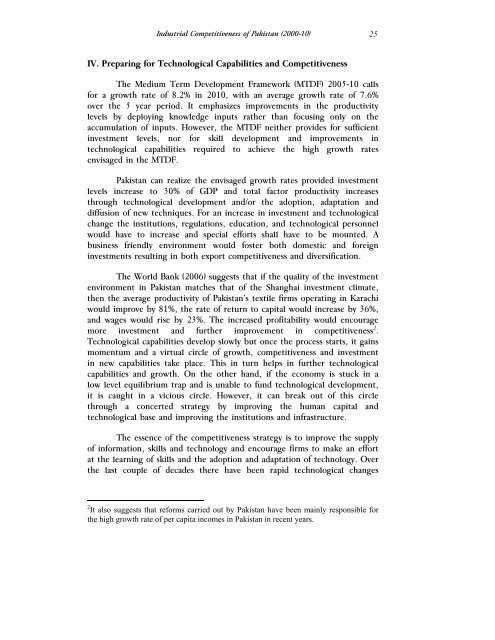Special Edition-07.pdf - Lahore School of Economics
Special Edition-07.pdf - Lahore School of Economics
Special Edition-07.pdf - Lahore School of Economics
Create successful ePaper yourself
Turn your PDF publications into a flip-book with our unique Google optimized e-Paper software.
Industrial Competitiveness <strong>of</strong> Pakistan (2000-10) 25<br />
IV. Preparing for Technological Capabilities and Competitiveness<br />
The Medium Term Development Framework (MTDF) 2005-10 calls<br />
for a growth rate <strong>of</strong> 8.2% in 2010, with an average growth rate <strong>of</strong> 7.6%<br />
over the 5 year period. It emphasizes improvements in the productivity<br />
levels by deploying knowledge inputs rather than focusing only on the<br />
accumulation <strong>of</strong> inputs. However, the MTDF neither provides for sufficient<br />
investment levels, nor for skill development and improvements in<br />
technological capabilities required to achieve the high growth rates<br />
envisaged in the MTDF.<br />
Pakistan can realize the envisaged growth rates provided investment<br />
levels increase to 30% <strong>of</strong> GDP and total factor productivity increases<br />
through technological development and/or the adoption, adaptation and<br />
diffusion <strong>of</strong> new techniques. For an increase in investment and technological<br />
change the institutions, regulations, education, and technological personnel<br />
would have to increase and special efforts shall have to be mounted. A<br />
business friendly environment would foster both domestic and foreign<br />
investments resulting in both export competitiveness and diversification.<br />
The World Bank (2006) suggests that if the quality <strong>of</strong> the investment<br />
environment in Pakistan matches that <strong>of</strong> the Shanghai investment climate,<br />
then the average productivity <strong>of</strong> Pakistan’s textile firms operating in Karachi<br />
would improve by 81%, the rate <strong>of</strong> return to capital would increase by 36%,<br />
and wages would rise by 23%. The increased pr<strong>of</strong>itability would encourage<br />
more investment and further improvement in competitiveness 2 .<br />
Technological capabilities develop slowly but once the process starts, it gains<br />
momentum and a virtual circle <strong>of</strong> growth, competitiveness and investment<br />
in new capabilities take place. This in turn helps in further technological<br />
capabilities and growth. On the other hand, if the economy is stuck in a<br />
low level equilibrium trap and is unable to fund technological development,<br />
it is caught in a vicious circle. However, it can break out <strong>of</strong> this circle<br />
through a concerted strategy by improving the human capital and<br />
technological base and improving the institutions and infrastructure.<br />
The essence <strong>of</strong> the competitiveness strategy is to improve the supply<br />
<strong>of</strong> information, skills and technology and encourage firms to make an effort<br />
at the learning <strong>of</strong> skills and the adoption and adaptation <strong>of</strong> technology. Over<br />
the last couple <strong>of</strong> decades there have been rapid technological changes<br />
2 It also suggests that reforms carried out by Pakistan have been mainly responsible for<br />
the high growth rate <strong>of</strong> per capita incomes in Pakistan in recent years.

















